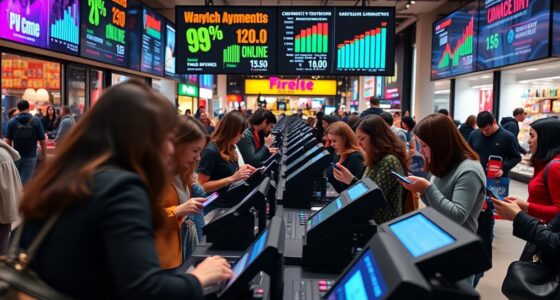By 2025, the global e-commerce market is expected to surpass $8 trillion, with China and the U.S. leading growth. You’ll see that digital wallets and mobile payments account for over 70% of transactions, emphasizing their dominance. Mobile commerce will continue to grow rapidly, shaping consumer behavior worldwide. If you want to understand which regions are expanding fastest and the latest payment trends, you’ll find the details quite revealing as you explore further.
Key Takeaways
- China leads with over $3 trillion in online sales, dominating the global e-commerce market, followed by the U.S. with over $1 trillion.
- E-commerce is projected to reach between $6.86 trillion and $8.3 trillion globally in 2025, accounting for nearly 20% of retail sales.
- Over 28 million online stores exist worldwide, with Shopify supporting nearly one-third of all e-commerce websites.
- Digital wallets facilitate over half of online transactions, with mobile commerce comprising more than 70% of purchases.
- Growth is driven by increasing internet and smartphone adoption, social commerce integration, and advancements in digital payment infrastructure.

As we look toward 2025, the global e-commerce landscape continues its rapid expansion, driven by rising internet and smartphone adoption worldwide. You’re witnessing a marketplace that’s projected to reach between $6.86 trillion and $8.3 trillion in sales, depending on the source. This growth isn’t happening randomly; it’s a steady climb that’s roughly doubling retail sales growth rates compared to traditional brick-and-mortar stores. Mobile commerce is at the forefront, accounting for over 70% of all online purchases, signaling a clear shift toward smartphones and tablets as the primary shopping devices. Consumers are increasingly prioritizing convenience, which is reflected in the widespread use of digital wallets. Over half of all online transactions now involve digital wallets, emphasizing the importance of secure, fast, and seamless payment options. [The growth of social commerce platforms like TikTok and Instagram is further fueling this trend, integrating shopping directly into social media experiences.] You’ll also notice that B2B e-commerce revenue has surpassed B2C, with the combined value reaching $34.1 trillion in 2024 and expected to exceed $71 trillion by 2030. This highlights how businesses are rapidly shifting their purchasing behaviors online, making e-commerce a critical component of global trade. When looking at regional markets, China dominates with over $3 trillion in annual sales, representing more than half of all global online sales. The United States follows as the second-largest market, generating over $1 trillion, which is roughly a third of China’s volume. Other countries show significant growth potential, but their markets remain much smaller by comparison. Overall, e-commerce accounts for about 19.5% of all retail sales worldwide, a clear sign of its increasing share in the retail ecosystem.
You’ll also see a massive proliferation of online stores—over 28 million globally in 2025—growing nearly 3% compared to last year. Every day, around 2,162 new ecommerce websites launch, demonstrating the vibrant and competitive nature of the market. The United States hosts half of these online stores, underscoring its leadership position. Shopify remains the dominant platform, supporting nearly a third of all ecommerce sites, while other platforms like Wix, WooCommerce, and Squarespace contribute to a diverse digital storefront landscape. Mobile-first design and faster checkout processes have become standard, enhancing user experience and increasing conversion rates. Additionally, the continued expansion of digital payment infrastructure has made online transactions more accessible and secure worldwide. Consumer preferences continue to evolve, with speed, security, and convenience topping the list. Digital wallets and mobile payments are used in more than half of all transactions, confirming the mobile-first trend. Over 70% of ecommerce activity now happens on mobile devices, pushing platforms to optimize for smaller screens and quicker checkout processes. As internet penetration and smartphone adoption grow across the globe, advances in digital payment infrastructure and social media integration will further accelerate growth, making e-commerce an even more integral part of everyday life.
Frequently Asked Questions
How Will Emerging Markets Influence Global E-Commerce Growth?
Emerging markets will markedly boost global e-commerce growth by expanding internet access and mobile device use, making shopping more accessible and convenient for you. As middle-class incomes rise, you’ll find more diverse products and faster delivery options tailored to local preferences. Digital payment innovations like wallets and BNPL make transactions smoother. By adapting to local cultures and logistics, businesses will better serve these markets, fueling worldwide online shopping expansion.
What Are the Environmental Impacts of Increased Online Shopping?
Imagine a double-edged sword—you gain convenience but cut into the environment. As you shop online more, you contribute to soaring shipping emissions, packaging waste, and product returns. Delivery vehicles increase traffic and pollution, while excess packaging adds to landfills. Your demand for fast, eco-conscious choices pushes businesses to reduce emissions, but the environmental toll persists. Your choices matter; embracing sustainable options can help balance convenience with environmental responsibility.
How Do Cultural Differences Shape Payment Preferences Worldwide?
Cultural differences heavily influence your payment preferences worldwide. You’re more likely to trust local methods like digital wallets in China or cash-on-delivery in Africa. Your familiarity and trust in financial systems drive choices, such as credit cards in the US or bank transfers in Germany. Younger generations prefer flexible options like BNPL or mobile payments. Understanding these cultural nuances helps merchants offer the right payment methods, boosting your confidence and reducing cart abandonment.
What Cybersecurity Challenges Are Expected in E-Commerce by 2025?
Imagine a world where every click opens a new door to danger—you face mounting cybersecurity challenges in 2025. You’ll contend with AI-driven fraud, where synthetic identities and convincing phishing emails slip past defenses. Omnichannel growth broadens attack surfaces, making vulnerabilities harder to pinpoint. Botnets and DDoS attacks surge, threatening your site’s availability. Staying ahead means deploying smarter, real-time security measures to protect customer trust and comply with evolving regulations.
How Will Regulations Evolve to Govern Cross-Border Transactions?
You’ll see regulations around cross-border transactions becoming more complex and globally coordinated. Governments will tighten rules on customs, taxes, and consumer protections, making compliance more challenging. Data privacy laws like GDPR will expand, requiring you to adapt your data management. Payment security standards will also evolve, pushing you to implement stronger fraud prevention measures. Staying updated and flexible will be vital to navigate these changing regulatory landscapes effectively.
Conclusion
As you look ahead to 2025, it’s clear that understanding key markets and evolving payment preferences is essential for your success. With rapid growth in regions like Asia and Africa, staying adaptable will set you apart. Are you ready to leverage these insights and innovate your approach? Embrace the change, and you’ll be well-positioned to thrive in the dynamic world of global e-commerce. The future belongs to those who stay ahead—are you ready to lead?









